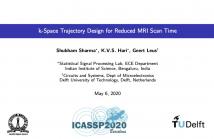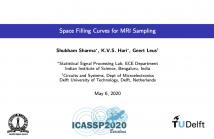
ICASSP is the world’s largest and most comprehensive technical conference focused on signal processing and its applications. The ICASSP 2020 conference will feature world-class presentations by internationally renowned speakers, cutting-edge session topics and provide a fantastic opportunity to network with like-minded professionals from around the world. Visit website.

The development of compressed sensing (CS) techniques for magnetic resonance imaging (MRI) is enabling a speedup of MRI scanning. To increase the incoherence in the sampling, a random selection of points on the k-space is deployed and a continuous trajectory is obtained by solving a traveling salesman problem (TSP) through these points. A feasible trajectory satisfying the gradient constraints is then obtained by parameterizing it using state-of-the-art methods. In this paper, a constrained convex optimization based method to obtain feasible trajectories is proposed.
- Categories:
 46 Views
46 Views
- Read more about Adaptive Blind Audio Source Extraction Supervised by Dominant Speaker Identification using X-vectors
- Log in to post comments
We propose a novel algorithm for adaptive blind audio source extraction. The proposed method is based on independent vector analysis and utilizes the auxiliary function optimization to achieve high convergence speed. The algorithm is partially supervised by a pilot signal related to the source of interest (SOI), which ensures that the method correctly extracts the utterance of the desired speaker. The pilot is based on the identification of a dominant speaker in the mixture using x-vectors. The properties of the x-vectors computed in the presence of cross-talk are experimentally analyzed.
- Categories:
 16 Views
16 Views
- Read more about SPACE FILLING CURVES FOR MRI SAMPLING
- Log in to post comments
A novel class of k-space trajectories for magnetic resonance imaging (MRI) sampling using space-filling curves (SFCs) is presented here. More specifically, Peano, Hilbert and Sierpinski curves are used. We propose 1-shot and 4-shot variable density SFCs by utilizing the space coverage provided by SFCs in different iterations. The proposed trajectories are compared with state-of-the-art echo-planar imaging (EPI) trajectories for 128 × 128 and 256 × 256 phantom and brain images.
- Categories:
 34 Views
34 Views
- Categories:
 11 Views
11 Views
- Read more about Effective Approximation of Bandlimited Signals and Their Samples
- Log in to post comments
- Categories:
 19 Views
19 Views
One out of four children in India are leaving grade eight without basic reading skills. Measuring the reading levels in a vast country like India poses significant hurdles. Recent advances in machine learning opens up the possibility of automating this task. However, the datasets of children’s speech are not only rare but are primarily in English. To solve this assessment problem and advance deep learning research in regional Indian languages, we present the ASER dataset of children in the age group of 6-14.
- Categories:
 12 Views
12 Views
- Read more about URTIS: A SMALL 3D IMAGING SONAR SENSOR FOR ROBOTIC APPLICATIONS
- Log in to post comments
- Categories:
 28 Views
28 Views
- Read more about SPATIAL ACTIVE NOISE CONTROL BASED ON KERNEL INTERPOLATION WITH DIRECTIONAL WEIGHTING
- Log in to post comments
A spatial active noise control (ANC) method taking prior information on the approximate direction of primary noise sources into consideration is proposed. ANC aims to cancel incoming primary noise using secondary loudspeakers. Conventional multipoint ANC does not guarantee the reduction of noise between multiple discrete control points; therefore, several attempts have been made to reduce the noise over an entire target region, i.e., by spatial ANC.
- Categories:
 95 Views
95 Views
- Read more about A NOVEL TWO-PATHWAY ENCODER-DECODER NETWORK FOR 3D FACE RECONSTRUCTION
- Log in to post comments
3D Morphable Model (3DMM) is a statistical tool widely employed in reconstructing 3D face shape. Existing methods are aimed at predicting 3DMM shape parameters with a single encoder but suffer from unclear distinction of different attributes. To address this problem, Two-Pathway Encoder-Decoder Network (2PEDN) is proposed to regress the identity and expression components via global and local pathways. Specifically, each 2D face image is cropped into global face and local details as the inputs for the corresponding pathways.
- Categories:
 25 Views
25 Views